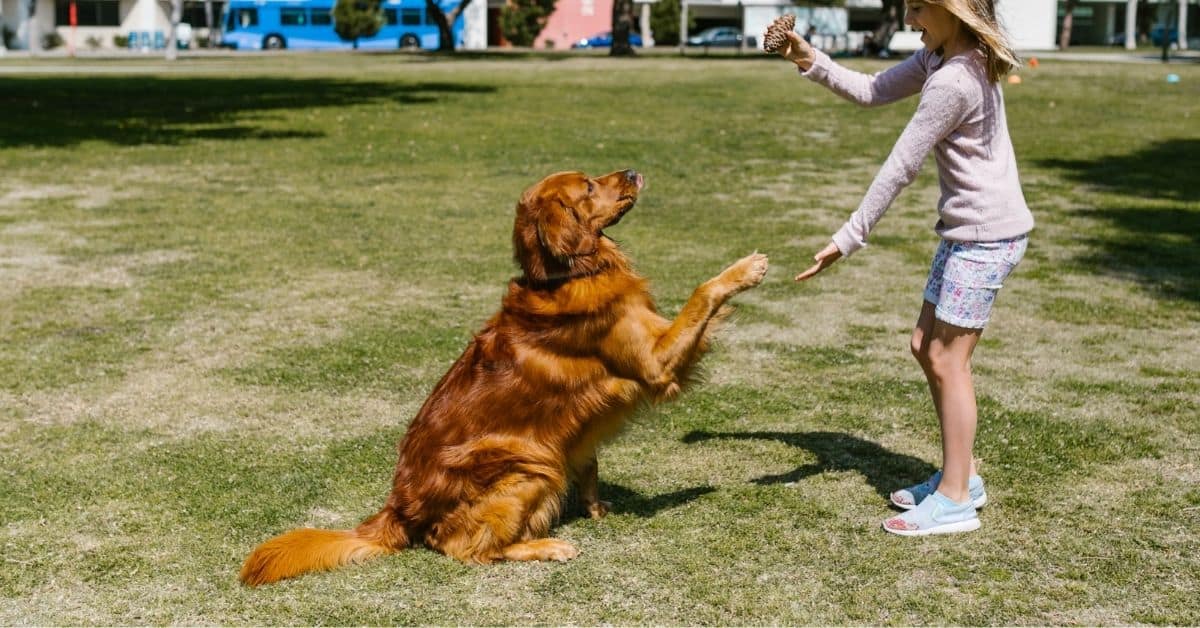In a world driven by screens and digital connections, an extraordinary bond continues to thrive, quietly changing the lives of countless children.
It’s a bond forged not through pixels or emojis but through something more profound and primal.
We’re talking about the enduring relationship between dogs and children, a connection that transcends time and space to touch the depths of the human soul.
And it’s not just a heartwarming tale; it’s a scientific marvel that can shape a child’s life trajectory.
The bond between dogs and children holds unparalleled transformative power, from boosting emotional intelligence to promoting physical well-being and even influencing cognitive development.
Prepare to be inspired and discover the countless ways man’s best friend becomes a child’s greatest ally.
Companionship
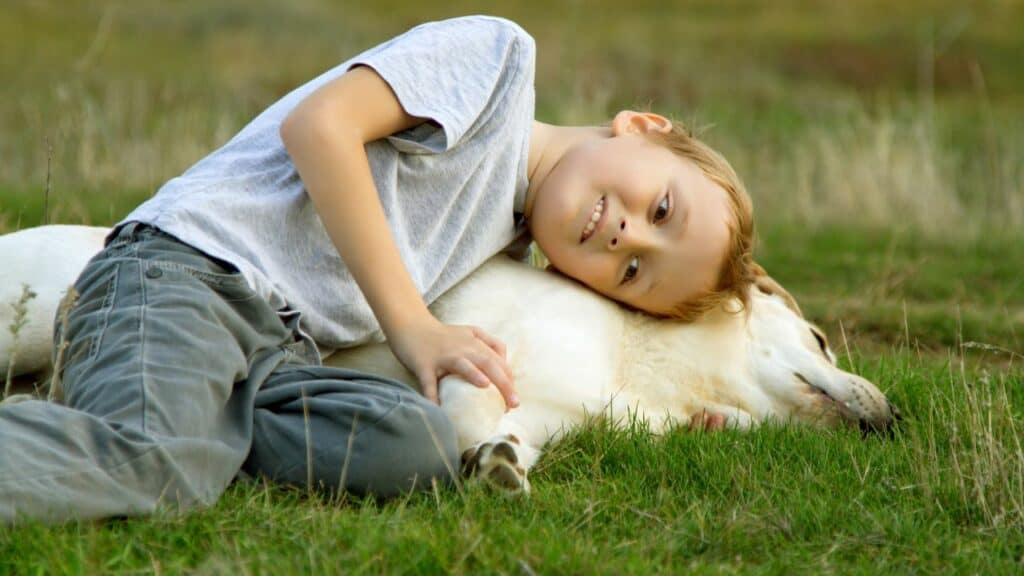
Dogs provide constant companionship for children, offering a loyal and loving presence.
Whether playing in the yard, cuddling on the couch, or taking walks together, dogs become steadfast companions, always ready to listen and be by a child’s side.
The unwavering companionship of a dog can help alleviate feelings of loneliness and provide a source of comfort and support, fostering a sense of belonging and connection in children.
Dogs have an innate ability to sense and respond to their human companion’s moods, offering solace during sadness or a playmate during moments of joy.
The presence of a dog provides children with a consistent and non-judgmental friend, someone they can rely on and confide in without fear of criticism or rejection.
Emotional Support
Interacting with dogs can help children develop emotional intelligence and learn empathy.
Dogs have a remarkable ability to understand and respond to human emotions, and as children spend time with their furry friends, they become attuned to the dog’s feelings and needs.
This interaction allows children to learn how to identify and regulate their own emotions while recognizing and responding to their dog’s emotions.
By observing and understanding their dog’s cues and body language, children develop a sense of empathy and compassion, learning to put themselves in another being’s shoes.
This heightened emotional awareness extends beyond the dog-human bond and becomes transferable to their interactions with other people, enhancing their ability to understand and connect with others on an emotional level.
Unconditional Love
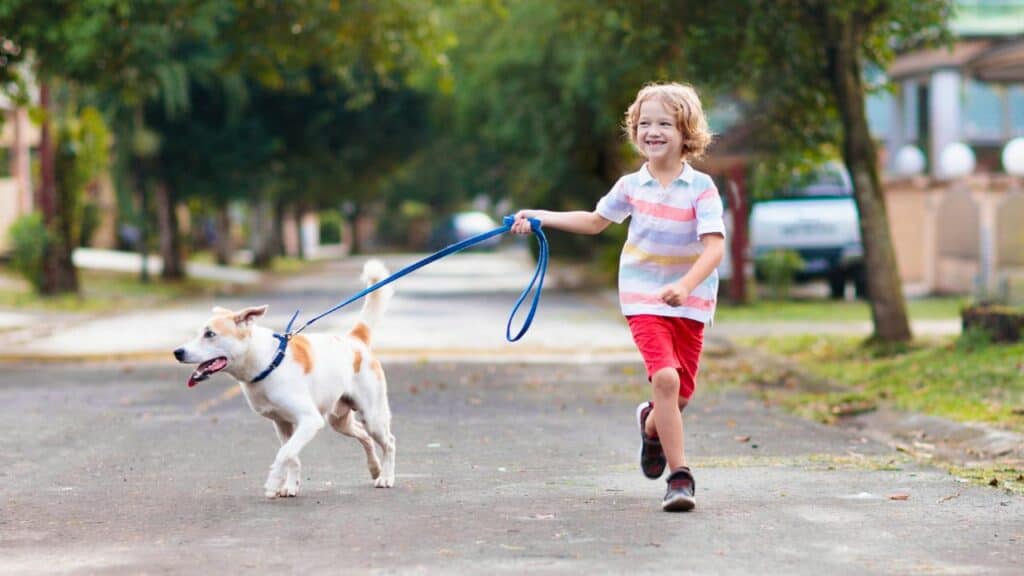
Dogs offer unconditional love, which can be especially beneficial for children experiencing challenging times or difficulties.
Dogs do not judge, criticize, or hold grudges.
Instead, they provide unwavering love and acceptance to their young companions.
This unconditional love from a dog can be a tremendous source of comfort and reassurance for children, boosting their self-esteem and creating a positive emotional environment where they feel safe and cherished.
A dog’s ability to love without conditions allows children to develop a deep sense of self-worth and a belief in their inherent value.
It teaches them they deserve love and affection, regardless of their flaws or mistakes, instilling self-confidence and emotional well-being.
Increased Physical Activity
Owning a dog encourages children to engage in physical activities such as walking, running, or playing fetch, promoting a healthy and active lifestyle.
Dogs need regular exercise, and involving children in these activities benefits the dog’s well-being and encourages kids to stay active.
Whether it’s a brisk walk around the neighborhood or an energetic game of fetch in the backyard, these physical activities keep children physically fit and instill healthy habits that can last a lifetime.
The bond between a child and their dog often motivates them to spend more time outdoors and engage in active play.
This increased physical activity not only contributes to better cardiovascular health but also helps in the development of coordination, balance, and motor skills.
Furthermore, regular exercise with a dog can reduce the risk of childhood obesity and associated health issues, setting the foundation for a healthy lifestyle.
Responsibility
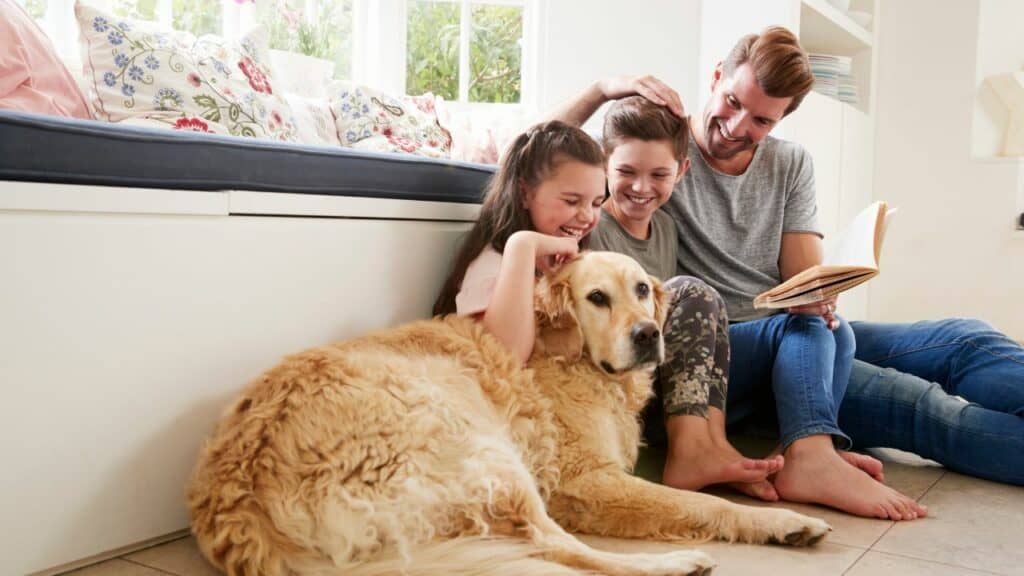
Caring for a dog teaches children about responsibility as they learn to feed, groom, and provide for their pet’s needs.
They understand the importance of routines and schedules for the dog’s well-being.
Caring for a dog also involves veterinary check-ups, vaccinations, and exercise, teaching children to prioritize health and safety.
Problem-solving skills are developed as children navigate challenges, fostering creative solutions.
This sense of responsibility nurtures a strong work ethic and empathy, extending to other aspects of their lives.
Witnessing the impact of their actions on their dog’s well-being fosters a heightened sense of responsibility in academics, chores, and relationships.
Social Skills Development
Dogs serve as social facilitators for children, fostering interactions with peers.
The shared interest in dogs provides a conversation topic, promoting social skills such as initiating conversations and empathy.
Children learn to navigate social dynamics, cooperate, and negotiate, developing vital skills beyond interactions with dogs.
Dogs offer non-judgmental support, allowing children to practice social skills without fear of rejection.
Interacting with dogs enhances emotional intelligence and understanding of nonverbal cues, which is essential for successful social interactions.
Reduced Stress And Anxiety
Interacting with dogs has been shown to lower stress levels and reduce anxiety, calming children.
The presence of a dog can act as a soothing presence, offering comfort and support during times of stress or anxiety.
Research has shown that petting a dog releases oxytocin, a hormone associated with feelings of relaxation and well-being.
Children can experience a sense of emotional relief and tranquility when stroking a dog’s fur or simply being in their presence.
Dogs have a unique ability to sense and respond to human emotions, often providing comfort and reassurance when a child feels overwhelmed or anxious.
The rhythmic and repetitive action of petting a dog can have a meditative effect, promoting mindfulness and helping children focus their attention on the present moment.
These calming interactions with dogs provide immediate relief from stress and teach children self-regulation techniques that they can apply in other challenging situations.
Enhanced Self-Esteem

Dogs offer unwavering acceptance and unconditional love, celebrating and cherishing children for who they are.
The bond between a child and their dog can boost self-esteem and confidence, as they feel loved and valued by their pet.
The bond between a child and their dog becomes a source of validation and emotional support, contributing to a positive self-image and a sense of self-worth.
Children often experience a unique sense of importance and responsibility when caring for their dogs, recognizing that they play a crucial role in their pet’s well-being.
Children develop a sense of mastery and accomplishment through daily care and interactions with their dogs.
Witnessing their dog respond to their commands, show affection, or display good behavior reinforces their belief in their abilities and strengths.
This sense of competence transfers to other aspects of their lives, leading to increased self-confidence and resilience when faced with challenges.
The responsibilities associated with dog ownership, such as feeding, grooming, and training, allow children to cultivate a sense of competence and capability.
Improved Mental Health
Owning a dog improves children’s mental health, reducing depression symptoms and enhancing overall well-being.
Dogs provide comfort and companionship, particularly for children facing emotional difficulties.
Petting a dog releases endorphins and serotonin, elevating mood and reducing anxiety.
Dogs alleviate loneliness, providing emotional support and a sense of belonging.
The physical activity associated with owning a dog improves mental health by releasing endorphins and reducing stress.
Engaging with their dog serves as a positive distraction and promotes mental well-being.
Enhanced Communication Skills
Interacting with a dog can help children improve their communication skills as they learn to give commands, offer praise, and understand nonverbal cues.
Dogs respond to verbal and nonverbal communication, encouraging children to develop effective communication skills.
When giving commands to their dog, children learn the importance of clear and concise instructions and the value of patience and consistency.
They develop the ability to express themselves assertively and confidently, practicing their communication skills in a supportive and non-judgmental environment.
Moreover, dogs communicate through body language, allowing children to understand nonverbal cues and learn to interpret and respond to their dog’s needs.
By observing their dog’s posture, facial expressions, and tail wagging, children become attuned to the nonverbal cues that dogs use to communicate.
This enhanced understanding of nonverbal communication extends to their interactions with other people, enabling children to recognize and respond to the emotions and needs of others more effectively.
Interacting with dogs also promotes active listening skills.
Dogs are attentive and responsive, and children quickly learn the importance of paying attention to their dog’s signals and cues.
They develop the ability to listen and interpret their dog’s needs, reinforcing the value of active listening in their communication with animals and people.
Learning Responsibility And Routine

Caring for a dog involves establishing routines for feeding, exercise, and grooming and teaching children valuable skills related to time management and consistency.
When children take responsibility for their furry companion’s daily needs, such as feeding them at specific times, ensuring they get regular exercise, and maintaining their grooming routine, they learn the importance of following schedules and being reliable.
By incorporating these responsibilities into their daily lives, children develop a sense of accountability and discipline.
This early exposure to responsibility and routine sets a foundation for future success in managing their time and commitments.
As they see the direct impact of their actions on their dog’s well-being, they learn the importance of providing consistent care and meeting the needs of another living being.
Teaching Empathy And Compassion
Dogs provide an opportunity for children to learn about empathy and compassion by understanding and responding to their pets needs.
Dogs rely on their human companions for care, affection, and attention.
When children observe and respond to their dog’s emotions and requirements, such as recognizing when they are hungry or need to go outside for a walk, they develop empathy and compassion.
They learn to be attuned to the feelings and needs of another living being, fostering a sense of kindness and understanding.
This valuable lesson extends beyond their relationship with dogs and equips children with the ability to empathize with and support others in their lives.
As children see the impact of their actions on their dog’s well-being, they develop a sense of responsibility for the emotional and physical welfare of others.
Stress Relief
Dogs can act as stress relievers for children, providing a source of comfort and support during challenging situations or when facing academic pressures.
The simple act of stroking a dog’s fur and feeling its warmth can have a calming effect, reducing stress levels and promoting relaxation.
Dogs are non-judgmental listeners, offering solace to children when they feel overwhelmed or anxious.
The physical presence of a dog can also release oxytocin, a hormone associated with reducing stress and increasing feelings of well-being.
Whether it’s cuddling with their dog after a long day or taking them for a walk to clear their mind, children find comfort and emotional support in their furry companions.
The bond between a child and their dog provides a safe space for children to express their emotions and find solace during times of stress.
Increased Social Support
Dogs can serve as a source of social support for children, offering a non-judgmental and comforting presence during times of loneliness or distress.
For children who may feel isolated or struggle with making friends, a dog can be a reliable and constant companion.
Dogs provide unconditional love and acceptance, creating a safe space where children can be themselves without fear of rejection.
When children engage in activities with their dog, such as going to the park or participating in dog-related events, they often meet other dog owners or fellow dog enthusiasts, fostering social connections and building a supportive community.
The shared love for dogs becomes a common ground for children to connect with others, promoting social interaction and a sense of belonging.
Sense Of Security
Having a dog can provide children with a sense of security and safety, knowing that their furry friend is there to protect and watch over them.
Dogs are naturally protective of their human family members, and this instinctual behavior can provide reassurance to children.
Whether it’s a gentle bark alerting them to potential danger or the comfort of having a loyal and dedicated companion by their side, children find solace in the presence of their dog.
This sense of security nurtures a feeling of well-being and helps children develop confidence in navigating the world around them.
Improved Cognitive Development
Interacting with dogs can stimulate cognitive development in children as they engage in activities such as training, problem-solving, and memory recall.
Teaching basic dog commands or engaging in more advanced training exercises requires children to use their cognitive skills, such as attention, concentration, and memory.
They learn to understand the cause-and-effect relationship between their commands and the dog’s response, enhancing their problem-solving abilities.
Additionally, dogs provide opportunities for children to exercise their memory recall skills as they remember and apply training techniques and commands consistently.
The cognitive challenges presented in dog training not only promote intellectual growth but also foster critical thinking and analytical skills.
Moreover, dogs can be involved in interactive games and puzzles that encourage children to think creatively and strategically.
From hiding treats for the dog to finding or designing obstacle courses, these activities promote cognitive flexibility and imaginative thinking.
Through these interactions with dogs, children develop cognitive skills that extend beyond the realm of pet ownership and contribute to their overall cognitive development.
Reduced Allergies And Asthma Risks
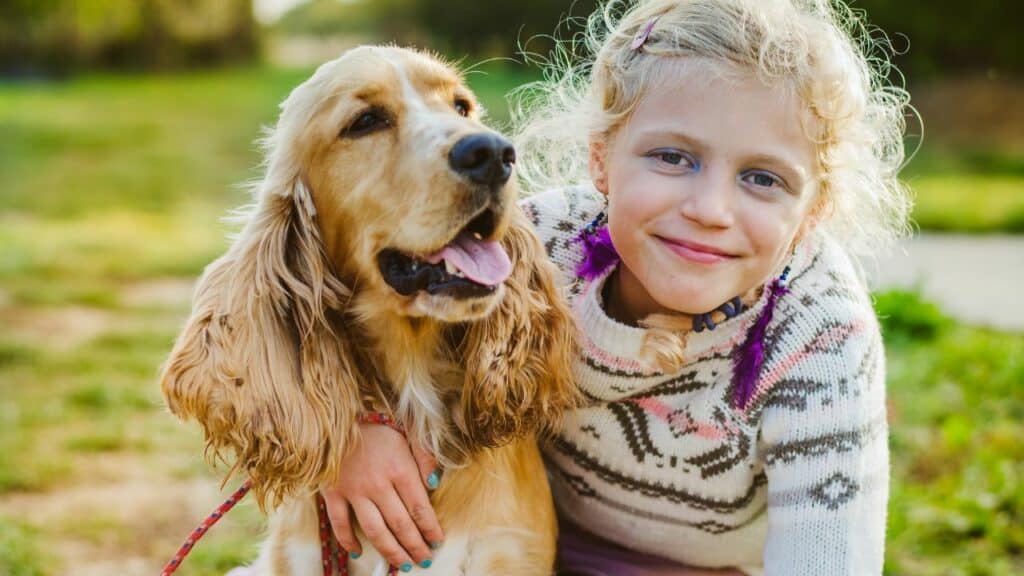
Research suggests that growing up with a dog in the household may help reduce the risk of allergies and asthma in children, potentially strengthening their immune systems.
Early exposure to dogs and their dander, fur, and outdoor elements can aid in the development of a child’s immune system.
Studies have shown that children who grow up in a dog-friendly environment tend to have a lower incidence of allergies and asthma compared to those without pets.
The presence of dogs in the home may help children build a tolerance to allergens, ultimately reducing the likelihood of developing allergic reactions or respiratory conditions.
This benefit highlights the potential long-term health advantages that can arise from the bond between children and their canine companions.
Enhanced Socialization Skills
Owning a dog can improve children’s socialization skills as they learn to communicate and interact with their pets, as well as with other dog owners and animal lovers in the community.
Dogs often serve as social facilitators, creating common ground for children to engage in conversations and activities with others.
Walking a dog in the neighborhood or visiting dog parks provides opportunities for children to meet and interact with other dog owners and enthusiasts.
These social interactions help children develop communication skills, such as initiating conversations, active listening, and understanding nonverbal cues.
Additionally, dogs can serve as a conversation starters or icebreaker, making it easier for children to connect with their peers and form new friendships.
Teaching Respect And Boundaries
Caring for a dog teaches children the importance of respecting boundaries and understanding the needs of others.
Dogs have their own preferences and comfort levels, and children learn to recognize and respect their pet’s signals when they need space or are feeling uneasy.
This understanding fosters empathy and an appreciation for the feelings and boundaries of others, essential qualities for healthy relationships.
Children also learn to handle their dogs with care, understanding that rough play or mishandling can cause discomfort or harm.
Through the bond with their dog, children develop a sense of responsibility and learn to treat animals and fellow humans with kindness and respect.
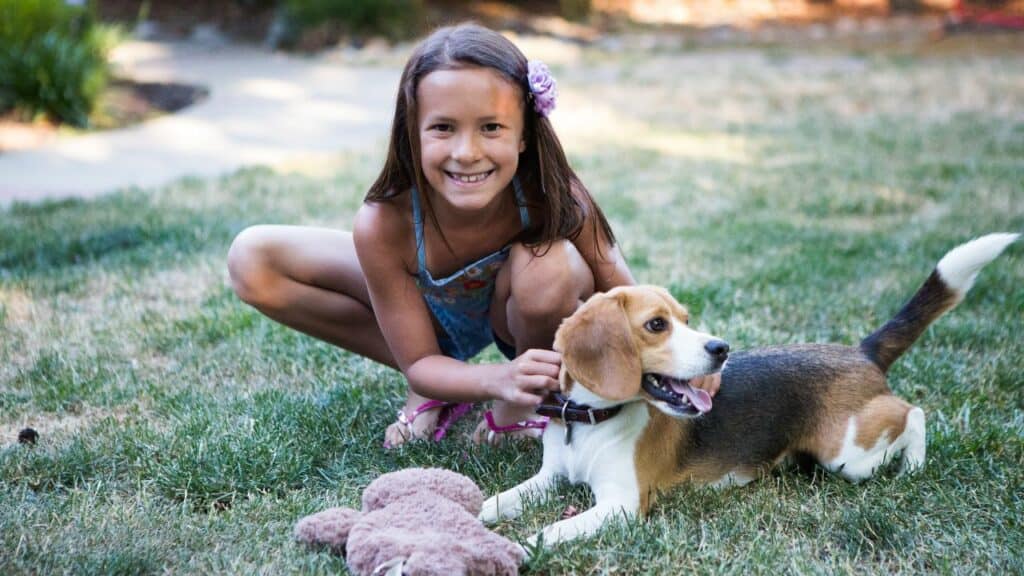
Encouraging Responsibility Towards The Environment
Owning a dog promotes responsible pet ownership, teaching children the importance of caring for the environment.
Children learn about proper waste disposal by cleaning up after their dogs and understanding the significance of keeping public spaces clean.
They develop an awareness of the impact their actions have on the environment and the importance of being conscientious about waste management.
Teaching children to be responsible pet owners extends to considering the environmental consequences of their choices, such as choosing eco-friendly pet products and minimizing their carbon footprint.
By instilling these values at a young age, owning a dog can contribute to raising environmentally conscious individuals who understand the importance of preserving the planet.
Before You Go…
If you want to learn more, watch the following video.

